Introduction
Front
{{section_header}}{{section.name}}{{/section_header}}

Back
{{section_header}}{{section.name}}{{/section_header}}

Sides
{{section_header}}{{section.name}}{{/section_header}}

Top
{{section_header}}{{section.name}}{{/section_header}}

Bottom
{{section_header}}{{section.name}}{{/section_header}}

In the Box
{{section_header}}{{section.name}}{{/section_header}}

As well as the camera itself, you get:
- AC adapter
- USB/power cable
- Battery
- Neck strap
- Lens cap
Not included are any A/V cables: you'll need to buy your own for showing still images and video on an analog or digital TV.
Color
{{section_header}}{{section.name}}{{/section_header}}
We found that the TL500 captured pretty accurate color in our tests, struggling only with a couple of colors out of the 24 on our test chart. In particular, it seemed to struggle with yellows, which came our rather darker and less vivid than the original color patches. The other colors were well represented, though, so the TL500 should have no major problems capturing the colors of the world. More on how we test color.
We test the color accuracy of all of the modes that the camera offers, and we found that the Normal mode was the most accurate. the other modes do mostly what the names suggest: cool gives everything a slight blue look, forest boosts the green, retro shoots in sepia, classic in black and white and vivid boosts the color saturation.
Color Modes
{{section_header}}{{section.name}}{{/section_header}}
The TL500 does not offer any direct color modes, but some of the photo styles produce a color shift, with vivid, cool, forest and classic doing what their names suggest to the colors in the image. If you would rather get the result after shooting the image, the same styles can be applied to images as they are being played back.
Noise
{{section_header}}{{section.name}}{{/section_header}}
We found that the images that the TL500 captured had very low noise across the ISO range of the camera. Although the noise level does climb at the higher ISO levels, it remains lower than most of our comparison models. More on how we test noise.
Our first noise test looks at the noise level across the ISO range shooting in two different situations: with lots of light (approx 3000 lux: the same as a cloudy day) and with little light (60 lux, equivalent to a poorly lit indoor room). The pattern of noise is much the same with both light levels, so you should not see a huge increase in noise if you have to jack the ISO up to shoot in low light.
The noise level of the TL500 is significantly lower than most of our comparison cameras, although it is a close call at some ISO levels. However, the TL500 has lower noise than most of our comparison cameras at the critical higher ISO levels.
{{comparison_bars title="Noise Score Comparison", attribute="Noise Score", xLabel="Noise Score"}}
ISO
{{section_header}}{{section.name}}{{/section_header}}
The TL500 supports a wide ISO range, shooting at sensitivities ranging from 80 to 3200 at the full resolution of the camera. Unusually, there is no way to push the sensitivity higher at a reduced resolution: there is no low light or high sensitivity scene mode.
NOTE: The images above are not used in our testing or scoring, but are included here to show real-world examples of the differences between cameras at the various ISO settings.
Resolution
{{section_header}}{{section.name}}{{/section_header}}
We were impressed with the resolution of the images that the TL500 captured; we found that they had some distortion, but very high sharpness and very little evidence of chromatic aberration. More on how we test resolution.
Distortion ({{product.raw_scores['Distortion Score']}})
The TL500 only offers a short zoom range, but we found a little bit of distortion in there: at the longest zoom setting, we found a noticeable 1.87 per cent of pincushion distortion, where straight lines bend in towards the center of the image. At the wide angle end of the zoom range, the opposite is true: here, we found 1.2 per cent barrel distortion. You can see examples of these distortions below. In these images, the red line is added after the image is captured.
Sharpness ({{product.raw_scores['Sharpness Score']}})
We were extremely impressed with the sharpness of the images that the TL500 captured; we found that fine details were well represented, without any oversharpening or overprocessing. Basically, the TL500 captures images with a lot of detail.
Chromatic Aberration ({{product.raw_scores['Chromatic Aberration Score']}})
That level of detail doesn't come at the cost of a lot of chromatic aberration: we found only a minimal amount of aberration in the images shot for our tests across the zoom range. There was slightly more aberration at the wide end of the zoom range, but even here, this was not a significant issue.
Quality & Size Options
{{section_header}}{{section.name}}{{/section_header}}
The TL500 offers 7 options for image quality: super fine, fine, normal, RAW, RAW and superfine, RAW & fine and RAW & normal. As the name of the last 4 suggests, they involve capturing both RAW images and compressed JPEG versions at the same time, which provides the best quality and a compressed version at the same time. These options do take a lot of space, though: a RAW file is typically about 22 to 25MB in size. In addition, there are 9 options available for the size of the image, detailed below. These include options with aspect ratios of 4:3 (the 10MK, 8M, 5M, 3M and 1M sizes), 16:9 (7M, 2M) and a rectangular, 1:1 aspect ratio ( the second 7M option).
Image Stabilization
{{section_header}}{{section.name}}{{/section_header}}
The TL500 offers two types of image stabilization: an optical system that shifts an element of the lens and an electronic system that boosts the sensitivity of the sensor. Our tests of the optical system revealed that it was quite effective, with average images taken with it turned on coming out significantly sharper than those taken with it turned off. It can't perform miracles, but it is worth enabling if you are taking photos in low light or without a tripod. More on how we test image stabilization.
Video Mode
{{section_header}}{{section.name}}{{/section_header}}
Despite having a big, bright screen, the TL500 has only limited movie features. It can capture videos at a resolution of up to 640 by 480 pixels at 30 frames per second with mono sound. That makes it a standard definition video device in an age where many cameras are capturing high definition video. The optical zoom can be used while recording, but we wouldn't recommend it, as the camera picks up an incredibly annoying buzzing noise, rather like an angry bee.
You can apply many of the image processing features to video, shooting video in the cool, calm, soft, retro and negative styles. The video files that it captures are saved as MPEG4 files, which might also prove to be a bit limiting: not all video editing applications can read this format.
Video Color
{{section_header}}{{section.name}}{{/section_header}}
We found that the TL500 captured movies with acceptable color, although it struggled with the same yellows and reds that it did with still images. More on how we test video color.
{{comparison_bars title="Video Color Score Comparison", attribute="Video Color Score", xLabel="Video Color Score"}}
Video Sharpness
{{section_header}}{{section.name}}{{/section_header}}
We found that the videos that the TL500 captured had decent sharpness for their resolution, but they were nothing to write (or indeed, post to YouTube) about. We found that fine details were fairly well captured, but that motion in the video caused this detail to rapidly break down: fast moving objects in the image became rather indiscriminate blurs a little quicker than we would like. More on how we test video sharpness.
{{comparison_bars title="Video Color Sharpness Comparison", attribute="Video Sharpness Score", xLabel="Video Sharpness Score"}}
Playback Mode
{{section_header}}{{section.name}}{{/section_header}}
The TL500 offers a number of different ways to view and sort the images it has captured. One slightly unusual feature is a facial recognition control called favorite faces. This allows you to prioritize the faces that are detected in images, and you can then search for a particular face.
In-Camera Editing
{{section_header}}{{section.name}}{{/section_header}}
A few basic editing features are available for captured images: they can be resized to smaller sizes, rotated, have a photo style or smart filter applied, red eye removed or have some basic corrections for color and contrast applied. There is no crop option on the editing menu, but you can crop images by zooming in on them and pressing OK to create a cropped version.
Videos can also be edited, with options to trim and split video files after capture.
Direct Print Options
{{section_header}}{{section.name}}{{/section_header}}
The usual support for DPOF and PictBridge printing is present on this camera, allowing images to be flagged for later printing and for the camera to connect directly to a PictBridge camera.
Viewfinder
{{section_header}}{{section.name}}{{/section_header}}
There is no viewfinder on this camera: all images a previewed through the AMOLED screen.
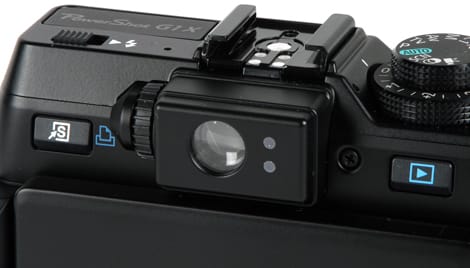

... and it has a diopter adjustment ring.
Display
{{section_header}}{{section.name}}{{/section_header}}
The TL500 has a large 3-inch AMOLED screen on the back. This has a resolution of 614k, and it looks great, with bright colors and plenty of detail. It doesn't have a huge contrast range, though: blacks in images looks slightly grey, so you don't get the dramatic impact of a photo. It also does get rather pale in bright daylight; you have to shield it from the sun to be able to see the image on the screen in direct sunlight.
The screen is also on a rotating pivot that allows it to both flip out and rotate. This means that you can use the screen to preview the image while shooting from above or below, as well as rotating it around to provide a self-portrait preview.

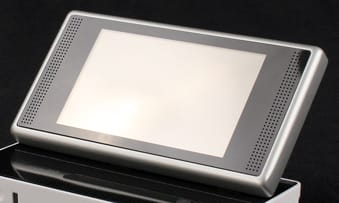
...but it turns into a nice 3-inch widescreen in playback mode.
Flash
{{section_header}}{{section.name}}{{/section_header}}
The built-in flash of the TL500 is a small pop-out model on the top of the camera body. This is a good arrangement; it keeps the flash out of the way when not required and also moves the flash away from the lens, minimizing red-eye. We found the flash to be reasonably powerful, illuminating objects in the dark up to 13-14 feet away.
A hot shoe on the top allows you to attach a separate flash unit, and any standard flash unit should work. Samsung says that the TL500 is also compatible with the flash designed for their NX10 SLR camera (the ED-SEF20A), which is more powerful than the built-in unit and supports TTL (Through The Lens) flash metering.

The flash emitter pops up from the top of the body via a mechanical release.
Lens
{{section_header}}{{section.name}}{{/section_header}}
The lens is one of the highlights of the TL500, with a very wide f/1.8 aperture. This means two things: the camera can have a really short depth of field (so you can shoot a portrait with a nice soft background) and it can gather a lot of light for more effective low light shooting.

The lens has an extremely wide zoom as well: 5.2mm, which is equivalent to a 24mm on a 35mm film camera. This means that it provides a wider angle of view for shooting landscapes, group shots and close-ups. The downside is that the lens has a relatively short zoom range: 3X, with a maximum telephoto zoom of 15.6mm, equivalent to a 72mm lens on a 35mm camera. That means that this lens can't get close in on the action; this camera simply does not have the zoom capabilities of other point & shoot cameras. Samsung does offer an adapter that takes the lens even wider (the LWCEX1, which converts it to an 18mm wide angle), but there is no way to make the telephoto end of the zoom any longer.
Battery
{{section_header}}{{section.name}}{{/section_header}}
The battery of the TL500 hold 1130 mAh, and can be charged while it is still in the camera. Unusually, the same cable is used for the USB connection and for charging the camera, so you can do both at once. This also makes it easier: if you are taking along a laptop, you can use that as a charging source. We found in our informal tests that the battery lasted long enough for a couple of days of shooting, but a spare would be recommended for longer trips or if you use the camera to show photos a lot.

Memory
{{section_header}}{{section.name}}{{/section_header}}
The TL500 stores images on SDHC or SDXC memory cards that fit alongside the battery. While SDHC memory cards can hold a maximum of 32GB of data, the newer SDXC can hold a theoretical maximum of 2TB, which should be enough to satisfy the most avid RAW shooter. The largest SDXC cards currently available are 64GB.

Jacks, Ports & Plugs
{{section_header}}{{section.name}}{{/section_header}}
There are two ports located under a small cover on the right side of the camera body: one for the USB and battery charging connection, and a micro HDMI port for connecting to a HDMI equipped TV. The USB/charging port uses a proprietary connection, but the USB/charging cable is included. No HDMI cable is included: If you want to view the images and video this camera captures on a HDTV, you'll need to spend extra on a cable with a micro HDMI plug on one end.
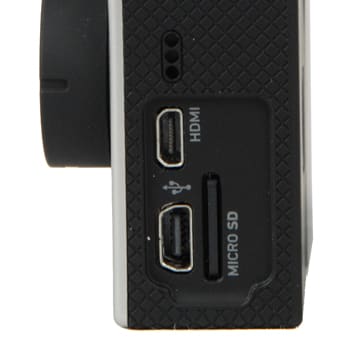
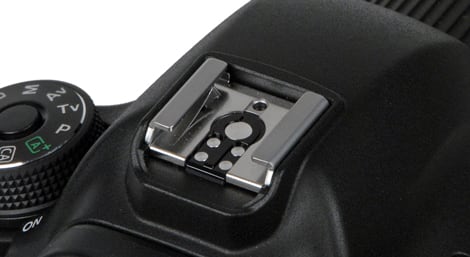
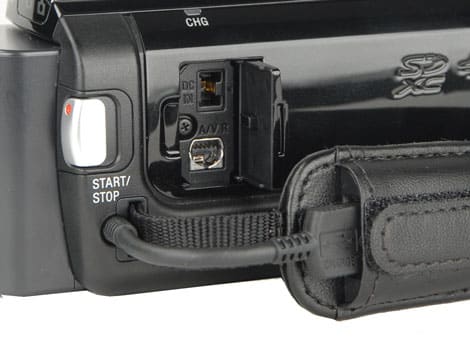
The DC-input and multi-AV port are located on the right side of the camcorder.
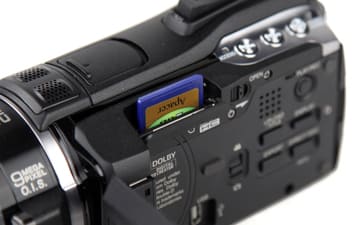
... as is the SD/SDHC card slot.
Shooting Modes
{{section_header}}{{section.name}}{{/section_header}}
The TL500 offers plenty of control over the shooting process, with a wide range of shooting modes. Twisting the mode dial to the Smart setting turns the camera into a true point and shoot, as the camera automatically picks a scene mode. The only control the user gets is picking the image size and turning the flash on or off. Program mode provides more control, and aperture and shutter priority put the user in the driving seat. Serious photographers will set the camera to the full manual mode, where the user gets control over shutter speed, aperture and all other settings.
Auto Mode Features
Focus - We found the AF system to be generally responsive and quick to find the right point, although it did sometimes swim a bit in low light. It also offers a good face detection system which can detect up to 10 faces in a frame. It can also detect smiles and even individual faces. Those you want to make sure are in focus can also be set as favorite faces, and the camera will detect and focus in on those particular faces.
Exposure - The TL500 offers a wide selection of tools for controlling the exposure of the camera, including the ability to apply 2 stops of exposure compensation, in one third of a stop steps. The exposure compensation is controlled with the EV dial on the front of the camera body.
In addition, the TL500 can capture 3 bracketed frames using either white balance or exposure bracketing. The camera can also use the bracketing feature to capture 9 images using all of the photo styles options it offers with a single press of the shutter button.
Metering - The usual options are on offer here: there are multi, center weighted and spot metering modes available.
Self-Timer - The TL500 offers the standard 2 and 10-second delays, plus a face detect mode that can be used to take a self-portrait when you are correctly framed. Support is also offered for an optional remote, but there is no support for interval shooting or other customizable self-timer modes, which is disappointing.

The full mode dial is nice, but frequently rotates by accident.
Scene Modes
The TL500 also offers a decent selection of scene modes (12 in total) that are available from the SCN spot on the mode dial. These scene modes cover a wide variety of shooting situations, including Beauty Shot (which softens skin tones), Night, Portrait, Children and Landscape. In addition, the dual IS mode available from the mode dials uses both electronic and optical stabilization.
Picture Effects
{{section_header}}{{section.name}}{{/section_header}}
The TL500 offer three special effects modes, called Smart Filter. Examples of these are shown below. These can also be applied to images after they have been captured.
Manual Controls
{{section_header}}{{section.name}}{{/section_header}}
Focus - In the manual mode, you control the focus point with up and down on the directional pad, and the screen shows an enlarged part of the center of the screen. There are also four options for the focus area: center, multi (9-point), selection and tracking. The first two are pretty straightforward, but the selection option allows you to set a particular point in the frame to focus on by moving the target around the center two thirds of the image. The tracking option will try and keep the object in the center of the frame in focus as it moves around the frame, and we found that it worked well, although it was unable to track very fast moving objects, or those that changed shape (such as a person turning around).
White Balance - A decent selection of white balance controls are offered: 5 presets, auto, evaluative and an option to enter the color temperature in degrees kelvin directly. The latter is unusual on a point & shoot, but could be useful.
Aperture - As befits a camera with extensive manual controls, the TL500 offers a good aperture range and control over how to use it. At the wide angle zoom setting, the lens offers a very wide f/1.8 aperture, which is great for gathering a lot of light and keeping the depth of field short. The aperture priority and manual modes also make it easy to control the aperture.
Shutter Speed - In auto mode, the shutter speed range of this camera is from 1/8 to 1/1500 of a second. That gets extended to 1 second in program mode, 8 seconds in the night scene mode and 16 seconds in aperture, shutter priority and manual modes. That's a wide enough range for most uses, although it would have been nice to have a faster speed to freeze objects in motion.
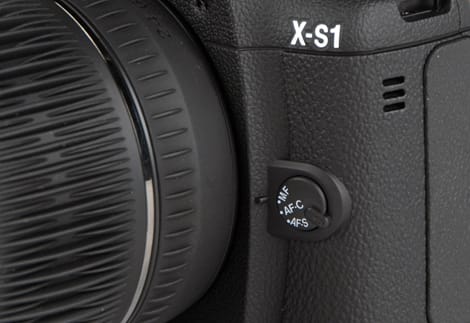
A dedicated focus-mode switch on the front panel.
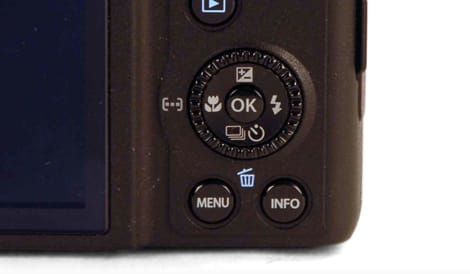
The scroll wheel surrounding the d-pad is neither awful nor perfect.
Drive/Burst Mode
{{section_header}}{{section.name}}{{/section_header}}
The TL500 offers two drive modes: single shot or continuous. In the latter mode, the camera keeps taking photos for as long as the shutter is held down, until the camera runs out of memory. There are no variable or higher speed modes.
Shot to Shot ({{product.raw_scores['Shot to Shot Score']}})
Shooting in the continuous mode in the highest JPEG quality and resolution, the TL500 managed to capture an average of 1.4 frames per second. That's a little on the low side, but it is adequate for capturing many things, and it is good that it is unlimited: using a 4GB SDHC card, we found the camera had no problem at all capturing continuously at this speed until the card filled up.
Handling
{{section_header}}{{section.name}}{{/section_header}}
Shooting in the continuous mode in the highest JPEG quality and resolution, the TL500 managed to capture an average of 1.4 frames per second. That's a little on the low side, but it is adequate for capturing many things, and it is good that it is unlimited: using a 4GB SDHC card, we found the camera had no problem at all capturing continuously at this speed until the card filled up.




These dedicated buttons give you quick access to aperture and shutter speed controls.
Buttons & Dials
{{section_header}}{{section.name}}{{/section_header}}
The TL500 has a lot of buttons and dials on the camera body, and these can be a little overwhelming for novice users. They are well laid out, though, with a consistent approach that makes it easy to navigate the camera.
On the top of the camera body are the shutter and zoom controls, plus the two mode dials. The drive mode dial (on the left in the photo below) controls the drive mode of the camera, setting the self timer and burst mode, as well as providing an option to enable the bracketing features of the camera. The second mode dial on the top of the camera sets the shooting mode, with options for Program, Aperture, Shutter, Manual, Dual IS, Scene, and Movie.
Both of these dials can be turned using the thumb for one-handed use, but they are more comfortable to use with the camera held in two hands.
On the back of the body are the other controls, with dedicated buttons for exposure lock, movie record, menu and metering above the directional pad. This directional pad is surrounded by a scroll wheel which can be used to scroll through images or adjust the aperture setting in A or M mode. The 4 directional buttons are used to navigate menus and to control the display, the flash, the AF and the ISO. An OK button in the center is used to select a menu option or finalize the choice of a list item.
Below this are two more dedicated buttons for playback and accessing the function menu.


Menus
{{section_header}}{{section.name}}{{/section_header}}
The TL500 offers two different types of menu: the function menu and the main menu. The function menu is accessed by pressing the Fn button, and contains options that directly relate to the shooting process, such as image size, ISO, white balance, etc. The idea is that it makes these easily accessible, and it generally works well, although the list does get rather long when shooting in one of the manual or priority modes.
The other menu is the main menu that is accessed by pressing the menu button, which provides access to all of the camera features. This is divided into 5 sections: camera, movie, sound, display and settings. Again, the system works well, but there are a lot of options on each of the tabs, and finding the ones that you want is often confusing; the bracketing setting is on the bottom page of the camera options, for instance.
Manual & Learning
{{section_header}}{{section.name}}{{/section_header}}
The TL500 comes with a basic, but adequate, printed quick start manual. On the included CD is a more in depth user manual. Both of these are pretty good, explaining the features of this somewhat complex camera in good detail.
Canon PowerShot S90 Comparison
These two cameras take a slightly different approach to the business of taking photos, with the SD4000 keeping the control mostly in the cameras hands while the TL500 offers more manual controls. The flip side of this is size: the SD4000 is much smaller, lighter and easier to carry around, folding down to just 0.93 inches thick when not in use. By comparison, the TL500 is a big, bulky thing that weighs more and is much larger.
But the TL500 does have something to counterbalance this weight issue: a much better lens with an f/1.8 aperture that makes for more light gathering ability, and a bigger, better LCD screen. The TL500 was also the better performer overall in our tests, with much lower noise, sharper images and more effective image stabilization. The only area where the SD4000 performed better was in capturing movies: it can capture 720p high definition video, while the TL500 is limited to 640 by 480 standard definition.
Sony Cyber-shot DSC-TX7 Comparison
Both cameras are aimed at serious users who want flexibility and features, with both offering full manual control and a range of features that will appeal to creative users. But the two cameras take a different approach otherwise, with the S90 offering a control dial around the lens that makes it feel like a shrunken SLR while the TL500 offers a rotating screen and a plethora of buttons. Both offer good manual controls, though, allowing you to tweak both aperture and shutter speed at the same time (a real blessing for manual mode shooting) and to quickly go from manual control to automated point & shooting if required.
COMP 3
The TX7 is a slim, sexy supermodel compared to the TL500, but that's perhaps an unfair comparison. While the TX7 offers a number of useful shooting features (such as the low light and panorama modes), it doesn't offer a full manual control or a lens anywhere near as good as the one on the TL500. Perhaps we should put it this way: if you don't know what a full manual mode and wide aperture means, you'll be happy with the TX7, which is a sophisticated, high quality point & shoot camera. But if you do know what manual mode is and why a wide aperture is a good thing, the TL500 might be the better pick.
Conclusion
There is a lot to like with the TL500: serious shooters will love the f/1.8 lens, the full manual control and the rotating OLED screen. But there are also a few things missing, such as high def movie capture and the sleek looks of many other compact cameras.
We were impressed with the performance of the TL500, which scored highly in most of our tests, and especially highly in our noise and resolution tests. The images that we shot were very low in noise across the ISO range, remaining acceptable up to the maximum ISO of 3200. The noise was noticeable at the higher ISO levels, but was significantly lower than other cameras. We also found that the captured images were very sharp, with great levels of detail and little artifacting across the frame.
But there are a few things that we miss. Although the f/1.8 lens has a very good wide angle setting (equivalent to a 24mm), it does not have a long zoom range, maxing out at the relatively short equivalent of 72mm. Samsung does offer an adapter that makes this wide angle even wider, but there is no equivalent adapter to get you any closer to the action. And while the OLED screen looks great, the TL500 is rather let down by only capturing standard definition video.
Photo Gallery
{{photo_gallery "Front Photo", "Back Photo", "Sides Photo", "Top Photo", "Bottom Photo", "Lens Photo", "Flash Photo", "EVF Photo 1", "EVF Photo 2", "LCD Photo 1", "LCD Photo 2", "Media Photo", "Modes Photo", "Manual Controls Photo", "Manual Controls Photo 2", "Other Controls", "Buttons 1", "Buttons 2", "Other Hardware Photo", "Battery Photo", "Ports Photo 1", "Ports Photo 2", "Ports Photo 3", "Ports Photo 4", "Handling Photo 1", "Handling Photo 2", "Handling Photo 3", "Box Photo"}}
Meet the tester
Richard Baguley is a veteran writer who has written about technology ranging from Alphabet to Zip file utilities. He has contributed to pretty much every major tech publication, including Amiga Format Magazine, PC World, Wired, CNET, Toms Guide, Forbes, and many others. He lives in the Boston metro area with his wife, dog, and an indeterminate number of cats.
Checking our work.
Our team is here to help you buy the best stuff and love what you own. Our writers, editors, and experts obsess over the products we cover to make sure you're confident and satisfied. Have a different opinion about something we recommend? Email us and we'll compare notes.
Shoot us an email